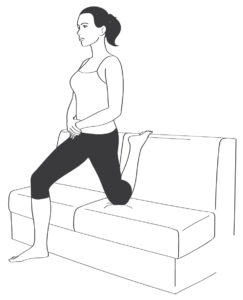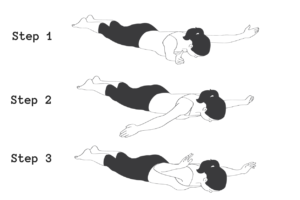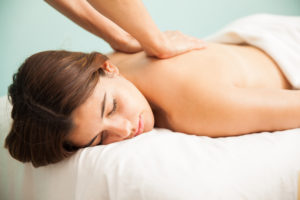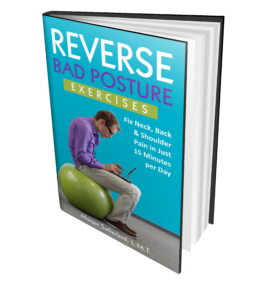Sitting for long periods can inevitably lead to a hunchback posture. In this article, you will learn how to fix hunched neck and shoulders in just four moves.
But what exactly is hunchback posture?
Forward head, slumping shoulders, a tilted pelvis, you know the telltale signs you’ve been teleported back to 15th-century Paris. (Quasimodo)
O.K., well, what if you don’t sit for hours on end at a desk, then chances are you might get a hunched neck, also known as text neck symptoms.
Hunched Neck is when your eyes are glued to your smartphone, and your head juts forward like a question mark. When you sustain a hunched neck posture while you clock in countless hours of screen time, the unfortunate result is chronic headaches, and shoulder, and neck pain.
How to Fix Hunched Neck and Shoulders in 4 Moves
#1- Book a Deep Tissue Massage
Of course, I need to plug deep tissue massage because it’s the number one way (in my opinion) that can help correct these postural distortions by relaxing, loosening, and stretching the overly tight and contracted muscles, teaching you what it feels like to be in proper alignment.
Not only does deep tissue massage provide immediate relief from muscle tension, but it also promotes better circulation, which aids in the recovery process and speeds up healing. Regular sessions can help break up scar tissue and improve range of motion, making everyday activities feel easier and less painful.
The more relaxed your muscles feel, the more liberated your joints will be, and this will inevitably improve your journey toward better posture and long-term body balance.
#2 – Couch Potato Quad Stretch

Sitting for long periods, puts the quadriceps muscles (thighs) in a constant contraction, keeping them short and tight.
Of the four quadriceps muscles, only one of them, the rectus femoris, attaches at the hip near the knee.
Tight quadriceps pull the pelvis forward at the front part of your hips, called the anterior superior iliac spine (ASIS). This pulling tilts the pelvis downward or forward, resulting in what’s called an anterior pelvic tilt.
This anterior tilt increases the arch in the lower back (referred to as lordosis), and this can make the back muscles tight and sore. Inadvertently, the tight quads can weaken or overstretch the hamstrings.
Proper postural alignment, and stretched-out quads, will help to balance and protect the low back muscles and keep them pain-free.
Start by placing your left knee on to the couch cushion with your left foot against the back of the couch. The closer your knee is to the back cushion, the more intense a stretch it will be; the farther from the back cushion, the easier it is.
If this is too painful for the top of your foot, place a rolled-up towel or small pillow underneath that foot/ankle.
Once you’ve gotten into this position, SLOWLY bring the right leg into a lunge, making sure that the knee is over the ankle and not past the toes.
From here, kick your left foot into the back cushion to contract (resist) the muscles on the front of the leg (quadriceps).
As you kick into the back cushion, use your other leg to push your body back to stretch the quads. As you go back, be sure to tuck the glutes under (the opposite of sticking your butt out) to increase the stretch.
Move back and forth for 1 minute. Then repeat on the other leg.
#3. Get into the Baby Camel Pose

Getting into the Camel pose can be quite a challenging backbend, so modifying it and doing the ‘baby version’ is a lot more doable for us inflexible folks.
Begin by tucking your toes under, and placing the palms of your hands into your sacrum. Lift from your chest as you slowly lean backward.
Keep your head in a neutral position aligned with your spine, and slowly lift your gaze towards the ceiling. Focus on opening up the front of your body and creating length in your spine without straining your lower back.
Hold for 5 breaths, paying attention to any tension in your shoulders and neck, and remember to come out of the pose gently by returning to an upright position. With regular practice, this modified version can help increase flexibility and gradually prepare you for the full Camel pose.
#4. Do the Prone YTW Exercise

Step 1: The “Y”
Lie on your stomach (preferably on a mat), gently exhale, and slowly lift your arms off the floor, moving your arms into the ‘Y’ formation with palms facing inward. Keep your head aligned with your upper spine.
Focus on lifting from the shoulders and not the lower back. Hold this position for one to two seconds, then relax and return to your starting position. Perform ten repetitions.
As you lift, imagine squeezing your shoulder blades together to engage your upper back muscles for maximum benefit.
Step 2: The “T”
From the same starting position, gently exhale, and slowly lift your arms off the floor, moving your arms into the “T” formation, as illustrated, with palms facing forward.
Hold this position for one to two seconds, then relax and return to your starting position. Perform ten repetitions.
Step 3: The “W”
Gently exhale, and slowly lift your arms off the floor. Bend your elbows and pull them toward your waist, forming the letter “W” with your palms facing inward.
Hold this position for one to two seconds, then relax and return to your starting position. Perform ten repetitions.
So now you know How to Fix Hunched Neck and Shoulders in 3 Moves.
Recommended Posture Book
If you’re looking for a way to improve your posture and reduce the chronic discomfort caused by slouching, hunching, or spending too much time on devices, Reverse Bad Posture Exercises is the solution you need.
In just 15 minutes a day, this book guides you through 21 simple exercises designed to correct forward head posture, rounded shoulders, and other common postural issues.
Whether you’re dealing with ‘text neck’ or general stiffness, these exercises will help you feel better and move more freely. You’ll be surprised at how quickly these small changes can make a big difference in your daily comfort and energy levels.
Plus, you’ll feel more confident, stand taller, and move with greater ease in your daily life—without spending hours at the gym.
Recommended Reading
6 Exercises to Reverse Bad Posture
5 Steps to Fix Forward Head and Prevent Text Neck Symptoms



